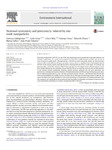Mostrar o rexistro simple do ítem
Neuronal Cytotoxicity and Genotoxicity Induced by Zinc Oxide Nanoparticles
| dc.contributor.author | Valdiglesias, Vanessa | |
| dc.contributor.author | Costa, C. | |
| dc.contributor.author | Kiliç, Gözde | |
| dc.contributor.author | Costa, Solange | |
| dc.contributor.author | Pásaro, Eduardo | |
| dc.contributor.author | Laffon, Blanca | |
| dc.contributor.author | Teixeira, João Paulo | |
| dc.date.accessioned | 2024-04-19T19:31:02Z | |
| dc.date.issued | 2013-03-26 | |
| dc.identifier.citation | Vanessa Valdiglesias, Carla Costa, Gözde Kiliç, Solange Costa, Eduardo Pásaro, Blanca Laffon, João Paulo Teixeira, Neuronal cytotoxicity and genotoxicity induced by zinc oxide nanoparticles, Environment International, Volume 55, 2013, Pages 92-100, ISSN 0160-4120, https://doi.org/10.1016/j.envint.2013.02.013. (https://www.sciencedirect.com/science/article/pii/S0160412013000615) | es_ES |
| dc.identifier.issn | 0160-4120 | |
| dc.identifier.uri | http://hdl.handle.net/2183/36273 | |
| dc.description.abstract | [Abstract] Zinc oxide nanoparticles (ZnO NPs) are one of the most abundantly used nanomaterials in consumer products and biomedical applications. As a result, human exposure to these NPs is highly frequent and they have become an issue of concern to public health. Although toxicity of ZnO NPs has been extensively studied and they have been shown to affect many different cell types and animal systems, there is a significant lack of toxicological data for ZnO NPs on the nervous system, especially for human neuronal cells and tissues. In this study, the cytotoxic and genotoxic effects of ZnO NPs on human SHSY5Y neuronal cells were investigated under different exposure conditions. Results obtained by flow cytometry showed that ZnO NPs do not enter the neuronal cells, but their presence in the medium induced cytotoxicity, including viability decrease, apoptosis and cell cycle alterations, and genotoxicity, including micronuclei production, H2AX phosphorylation and DNA damage, both primary and oxidative, on human neuronal cells in a dose- and time-dependent manner. Free Zn2+ ions released from the ZnO NPs were not responsible for the viability decrease, but their role on other types of cell damage cannot be ruled out. The results obtained in this work contribute to increase the knowledge on the genotoxic and cytotoxic potential of ZnO NPs in general, and specifically on human neuronal cells, but further investigations are required to understand the action mechanism underlying the cytotoxic and genotoxic effects observed. | es_ES |
| dc.description.sponsorship | This work was funded by the European Commission (ERA NET — New INDIGO Program, NanoLINEN — 045-036-073, PIM2010ENI-00632) and by Xunta de Galicia (EM 2012/079). G. Kiliç was supported by a fellowship from the University of A Coruña | es_ES |
| dc.description.sponsorship | Xunta de Galicia; EM 2012/079 | es_ES |
| dc.language.iso | eng | es_ES |
| dc.publisher | Elsevier | es_ES |
| dc.relation | info:eu-repo/grantAgreement/MICINN/Plan Nacional de I+D+i 2008-2011/PIM2010ENI-00632/ES/CONEXION EN NANOTOXICOLOGIA ENTRE INDIA Y LAS NACIONES EUROPEAS | es_ES |
| dc.relation.uri | https://doi.org/10.1016/j.envint.2013.02.013 | es_ES |
| dc.rights | © 2013 Elsevier Ltd. All rights reserved. | es_ES |
| dc.subject | Zinc oxide nanoparticles | es_ES |
| dc.subject | Cytotoxicity | es_ES |
| dc.subject | Genotoxicity | es_ES |
| dc.subject | Oxidative damage | es_ES |
| dc.subject | SHSY5Y cells | es_ES |
| dc.subject | Zn+2 ions | es_ES |
| dc.title | Neuronal Cytotoxicity and Genotoxicity Induced by Zinc Oxide Nanoparticles | es_ES |
| dc.type | info:eu-repo/semantics/article | es_ES |
| dc.rights.access | info:eu-repo/semantics/embargoedAccess | es_ES |
| dc.date.embargoEndDate | 9999-99-99 | es_ES |
| dc.date.embargoLift | 10007-06-07 | |
| UDC.journalTitle | Environment International | es_ES |
| UDC.volume | 55 (May 2013) | es_ES |
| UDC.startPage | 92 | es_ES |
| UDC.endPage | 100 | es_ES |
| dc.identifier.doi | 10.1016/j.envint.2013.02.013 |






